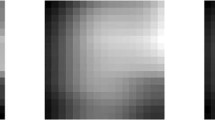Abstract
A rain streak in an image can degrade visual quality of that image to the human eye. Unfortunately, removing the rain streak from a single image represents a very challenging task. In this paper, a single image rain removal process based on non-negative matrix factorization is proposed. First, the rain image is broken down into a low-frequency and high-frequency part by a Gaussian filter. Therefore, the rain component, which lies mostly in the middle frequency range, can be discarded in high and low frequency domains. Next, non-negative matrix factorization (NMF) method is applied to deal with the rain streak in the low frequency domain. Finally, Canny edge detection and block copy strategy are performed separately to remove the rain component in the high frequency domain to improve image quality. In comparison with state-of-the-art approaches, the proposed method achieves competitive results without the need for an extra image database to train the dictionary.
















Similar content being viewed by others
References
Barnum PC, Narasimhan S, Kanade T (2010) Analysis of rain and snow in frequency space. Int J Comput Vis 86(2–3):256–274
Bossu J, Hautière N, Tarel J-P (2011) Rain or snow detection in image sequences through use of a histogram of orientation of streaks. Int J Comput Vis 93(3):348–367
Brewer N, Liu N (2008) Using the shape characteristics of rain to identify and remove rain from video. Lecture Notes in Computer Science, pp 451–458
Chen DY, Chen CC, Kang LW (2014) Visual depth guided color image rain streaks removal using sparse coding. IEEE Trans Circuits Syst Video Technol 24(8):1430–1455
Fang S, Xia X-S, Huo X, Chen C-W (2014) Image dehazing using polarization effects of objects and airlight. Opt Express 22(16):19523–19537
Garg K, Nayar SK (2004) Detection and removal of rain from videos. Proceedings of IEEE Computer Society Conference on Computer Vision and Pattern Recognition, pp 528–535
Garg K, Nayar SK (2005) When does a camera see rain?. Proceedings of IEEE International Conference on Computer Vision, pp 1067–1074
Garg K, Nayar SK (2006) Photorealistic rendering of rain streaks. ACM Trans Graph 25(3):996–1002
Garg K, Nayar SK (2007) Vision and rain. Int J Comput Vis 75(1):3–27
Gregor K, LeCun Y (2010) Learning fast approximations of sparse coding. Proceedings of the 27th International Conference on Machine Learning, pp 399–406
Grindlay G (2010) "NMFLib-Efficient Matlab library implementing a number of common NMF variants."http://www.ee.columbia.edu/~grindlay/code.html
He K, Sun J, Tang X (2011) Single image haze removal using dark channel prior. IEEE Trans Pattern Anal Mach Intell 33(12):2341–2353
Huang DA, Kang LW, Yang MC, Lin CW, Wang YCF (2012) Context-aware single image rain removal. IEEE International Conference on Multimedia and Expo, pp 164–169
Kang LW, Lin CW, Fu YH (2012) Automatic single-image-based rain streaks removal via image decomposition. IEEE Trans Image Process 21(4):1742–1755
Kang L-W, Zhuang B, Hsu C-C, Lin C-W, Yeh C-H (2013) Self-learning-based low-quality single image super resolution. Proceedings of IEEE International Workshop on Multimedia Signal Processing
Krishnan S, Venkataraman D (2012) Restoration of video by removing rain. Int J Comput Sci Eng Appl 2(2):19–28
Lee DD, Seung HS (1999) Learning the parts of objects by non-negative matrix factorization. Nature 401:788–791
Lee DD, Seung HS (2001) Algorithms for non-negative matrix factorization. Advances in neural information processing systems
Lin CJ (2007) Projected gradient methods for nonnegative matrix factorization. Neural Comput 19(10):2756–2779
Mairal J, Bach F, Ponce J, Sapiro G (2009) Online dictionary learning for sparse coding. Proceedings of International Conference on Machine Learning, pp 689–696
Mairal J, Bach F, Ponce J, Sapiro G (2010) Online learning for matrix factorization and sparse coding. J Mach Learn Res 11:19–60
Manu BN (2015) Rain removal from still images using L0 gradient minimization technique. IEEE International Conference on Information Technology and Electrical Engineering, pp 263–268
Shi Z, Long J, Tang W, Zhang C (2014) Single image dehazing in inhomogeneous atmosphere. Int J Light Electron Opt 125(15):3868–3875
Utaminingrum F, Somawirata I-K (2015) Rain streaks removal by using composite method. IEEE International Conference on Signal-Image Technology & Internet-Based Systems, pp 139–142
Wixson L (2000) Detecting salient motion by accumulating directionally-consistent flow. IEEE Trans Pattern Anal Mach Intell 22(8):774–780
Wren CR, Azarbayejani A, Darrell T, Pentland AP (1997) Pfinder: real-time tracking of the human body. IEEE Trans Pattern Anal Mach Intell 19(7):780–785
Xue X, Jin X, Zhang C, Goto S (2012) Motion robust rain detection and removal from videos. IEEE 14th International Workshop on Multimedia Signal Processing, pp 170–174
Yeh C-H, Kang L-W, Lin C-Y (2012) Image haze removal via haze density analysis based on pixel-based dark channel prior. Proceedings of Computer Vision & Graphic Image Processing
Yeh CH, Kang L-W, Lee M-S, Lin C-Y (2013) Haze effect removal from image via haze density estimation in optical model. Opt Express 21(22):27127–27141
Yeh C-H, Kang L-W, Chiou Y-W, Lin C-W, Jiang S-JF (2014) Self-learning-based post-processing for image/video deblocking via sparse representation. J Vis Commun Image Represent 25:891–903
Zhang X, Li H, Qi Y, Leow WK, Ng TK (2006) Rain removal in video by combining temporal and chromatic properties. Proceedings of IEEE International Conference on Multimedia and Expo, pp 461–464
Acknowledgements
This work was supported by Ministry of Science and Technology, Taiwan, under Grants MOST 103-2221-E-468-007-MY2, MOST 105-2221-E-155-083, MOST 103-2221-E-110-045-MY3, and NSC 102-2221-E-110-032-MY3.
Author information
Authors and Affiliations
Corresponding author
Rights and permissions
About this article
Cite this article
Yeh, CH., Lin, CY., Muchtar, K. et al. Rain streak removal based on non-negative matrix factorization. Multimed Tools Appl 77, 20001–20020 (2018). https://doi.org/10.1007/s11042-017-5430-2
Received:
Revised:
Accepted:
Published:
Issue Date:
DOI: https://doi.org/10.1007/s11042-017-5430-2




